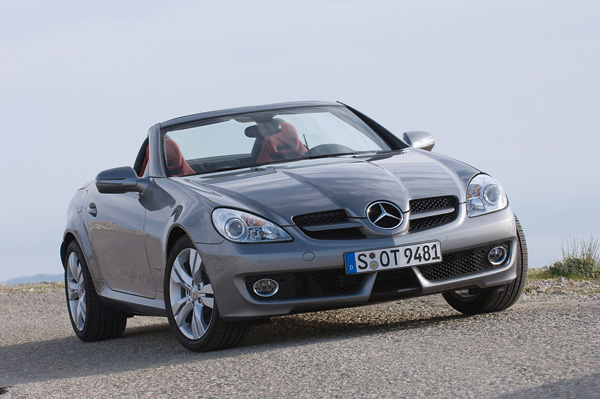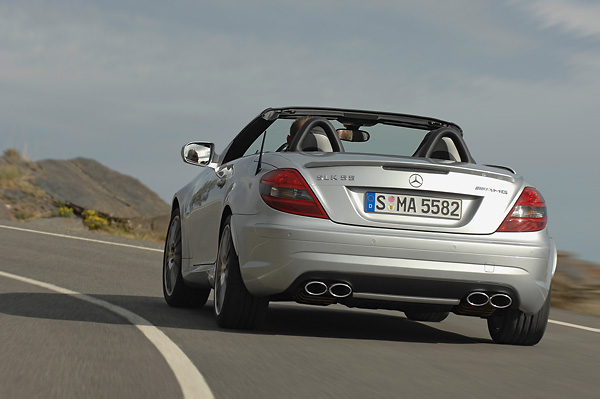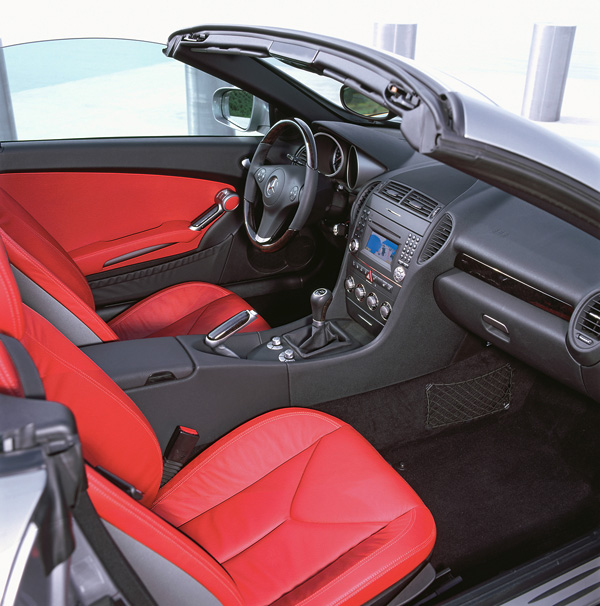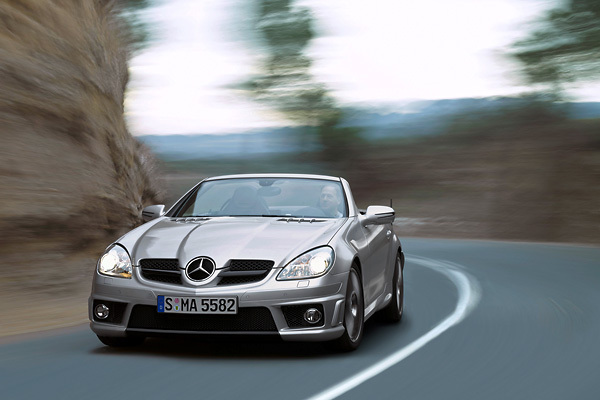The new-generation SLK – More powerful, more economical, more intense: rediscovering roadster driving pleasure

The Mercedes-Benz SLK-Class Roadsters have long captured the hearts of sports car enthusiasts. Following an extensive facelift incorporating around 650 newly developed components, the SLK models of 2008 are even more dynamic and now offer an even more emotionally charged driving experience. Key visual enhancements include new-look front and rear sections, as well as a meticulously modified interior with a new instrument cluster and three-spoke sports steering wheel. The high-revving V6 sports engine in the SLK 350 developing 224 kW/305 hp and an optionally available direct-steer system truly bring the bold, dynamic character of the two-seater to the fore. Furthermore, all of the engines in the line-up are now far more economical on fuel and therefore emit even less CO2, despite a substantial increase in output in some cases. The new-generation SLK models will be available for delivery from April 2008.
Since their first appearance in 1996, the compact SLK Roadsters have come to symbolize Mercedes-Benz’ dynamic brand image. Already a familiar sight on our roads, the second-generation two-seater is to be further enhanced with the implementation of a raft of measures in 2008, the aim being to further emphasize the car’s sporty character and continue the SLK-Class success story by introducing new dynamic and powerful elements. Some 310,000 first-generation roadster models were sold between 1996 and 2004. And around 185,000 customers – some 60,000 of them in Germany alone – have already purchased the second-generation model since its launch in March 2004 (figures at year-end 2007). This means that total unit sales of the SLK Roadster are now approaching the half-million mark. The second-generation SLK has therefore retained the car’s quite unique status in this market segment.
The new-generation SLK blazes a trail of new sporty highlights, bestowing yet greater appeal on this thriving two-seater with the trendsetting vario-roof that transforms the car from a roadster into a weatherproof coupé in a matter of seconds.

Distinctive character: even more pronounced V-shape at the front and a diffuser-style rear
The designers have honed the looks of the cult two-seater for added sportiness. Eye-catching features include the new-look front bumper with a modified air-dam arrangement and a more pronounced V-shape, while the area around the Mercedes star now stands out more boldly. The designers have also remodeled the vehicle’s tail, with the diffuser-look styling at the bottom giving the Roadster an even more powerful appearance from the rear too. This is further emphasized by the trapezoidal exhaust tailpipes and the AMG-inspired darkened tail lights. The now larger exterior mirrors feature LED indicators with a pronounced arrow shape, while the range of light-alloy wheels is also almost entirely new.

High-quality cockpit and new three-spoke sports steering wheel
Many of the interior’s details have undergone remodeling too, and the interior has been refined as a whole by meticulous material selection. Particular care was taken to optimize the interior in such a way as to make it that much more driver-focused again. Center pieces include a new three-spoke sports steering wheel with multifunction buttons as well as a new instrument cluster with intriguing-looking dial bezels.
New “gullwing red” leather appointments will now be available, which are reminiscent of the interior appointments in the legendary 300 SL gullwing model. Further new additions include nappa leather appointments in “natural beige”, which complement the new “pale burr walnut” and “black ash grain” wood trims perfectly.
Enhanced audio and telematics systems
Mercedes-Benz is installing the new NTG 2.5 generation of audio and telematics componentry in the SLK for the first time. This boasts improved user friendliness together with even more handy functions. Standard features integrated in every radio include a hands-free facility using Bluetooth technology, plus – as an option – a new media interface in the glove compartment, which enables mobile audio devices such as the iPod to be fully integrated into the audio system and operated from its control panel.
The switch to the new telematics generation now sees Mercedes-Benz offering the optimised LINGUATRONIC voice control system, renowned for its outstanding operation, as an option for the SLK-Class for the first time.
Voluminous surround sound even with the roof down
Passengers can enjoy a unique listening experience, regardless of whether the vario-roof is open or closed, thanks to the optionally available Harman Kardon® Logic7® sound system. Rich and voluminous surround sound makes for crystal-clear listening pleasure, the like of which has never before been associated with
a roadster.

High-revving sports engine: added power and considerably lower consumption
Making a mighty contribution to the sporty billing of the 2008 generation of the SLK are three reengineered drive units, which all make their mark with lower fuel consumption, resulting in reduced CO2 emissions. Both the four-cylinder engine in the SLK 200 KOMPRESSOR and the six-cylinder sports engine in the SLK 350 benefit from a substantial increase in output and torque. Only the SLK 55 AMG retains its familiar engine – an eight-cylinder unit that has lost none of its mesmerising performance capability and remains a unique selling point in the SLK segment.
The Mercedes-Benz engineers devoted particular attention to the V6 sports engine with high-revving concept, which is making its debut in the new-generation SLK. By performing a major overhaul of the engine’s mechanics, the engineers succeeded in giving the V6 unit a completely new lease of life. Although the displacement remains the same at 3498 cc, the engine now musters up 224 kW/305 hp at 6500 rpm – some 24 kW (33 hp) more than its predecessor. Torque has been upped too (+ 10 Nm) and now peaks at 360 Nm at 4900 rpm.
This has been achieved by raising the rev speed limit to 7200 rpm, at the same time as increasing the compression ratio, fitting a new intake manifold and making extensive modifications to the valve gear.
The new engine also strikes a far more emotive-sounding note after being deliberately tuned to deliver resonant sports engine acoustics, with overrun mode producing a particularly emotion-stirring sound. When partnered by the 7G‑TRONIC automatic transmission, the engine management furthermore triggers an automatic double-declutching function during downshifts – not only does this create a very sporty soundtrack, it helps to limit load-alteration effects too.
Yet despite its higher power output and such high-caliber performance, fuel consumption in the SLK 350 has been cut by a sizeable margin. With the six-speed manual transmission on board, combined fuel consumption is just 9.5 litres per 100 km, a remarkable reduction of 1.1 litres per 100 km; if the 7G-TRONIC automatic transmission is fitted, the sports engine limits itself to a mere 9.2 litres for every 100 km on the combined cycle – 0.9 litres less than previously. The cut in fuel consumption also lowers CO2 emissions by 23 g/km to 219 g/km on the automatic model (manual transmission: 227 g/km, a reduction of 28 g/km).
Choice of three further engines
Following the facelift, the engine line-up for the second generation of the successful SLK-Class will comprise three further variants:
-
The output of the four-cylinder supercharged engine has been boosted by 15 kW/21 hp (to 135 kW/184 hp), with torque increasing from 240 to 250
Newton meters. Combined fuel consumption has dropped by 1.0 liter to 7.7 l/100 km. This in turn reduces CO2 emissions by 27 g /km to 182 g/km. -
The SLK 280 has likewise been optimized for lower fuel consumption, and therefore CO2 emissions. Fuel consumption has dropped by 0.4 liters to 9.3 l/100 km (automatic: -0.2 l to 9.1 l/100 km) and CO2 emissions by 11 g to 220 g/km (automatic: -6 g to 216 g/km)
-
At work under the bonnet of the SLK 55 AMG is the familiar 5.5-litre V8 powerplant delivering 265 kW/360 hp and 510 Nm of torque.
The three new models in the SLK range all come with a precision six-speed manual gearshift. The SLK 55 AMG retains the 7G-TRONIC Sport seven-speed automatic transmission. The optional extras available include a five-speed automatic transmission for the SLK 200 as well as the 7G-TRONIC seven-speed automatic transmission or, alternatively, the 7G-TRONIC Sport with shift paddles on the steering wheel for the six-cylinder SLK 280 and SLK 350 sports engine models.
New direct-steer system for outstanding agility and tangible fun at the wheel
A newly developed direct-steer system with variable power assistance that elicits the very best from the suspension’s sporty capabilities is optionally available (standard on the SLK AMG 55). It combines agility and maneuverability on twisting country roads with light steering forces when parking and sure steering characteristics at high speeds.
The direct-steer system is derived from the previous speed-sensitive power steering and operates purely mechanically. This dispenses with the need for elaborate actuator units and complex sensors, which would otherwise impair the flow of forces between the wheels and hands, thereby compromising steering precision. At the heart of the system is a new rack with ingeniously devised gearing, which ensures that the steering gear ratio changes in tune with the steering angle. In and around the central position, the steering has an indirect ratio for good straight-line stability, resulting in tremendous assuredness when traveling at high speeds. At a steering angle of just 5 degrees, the ratio starts to increase very rapidly and the steering feels much more direct. As a result, the number of steering wheel turns from lock to lock is reduced by around 25 per cent with the new direct-steer system. Consequently, relatively small turns of the steering wheel are sufficient for changing course when driving in city traffic. Fast sequences of bends on rural roads, on the other hand, can be negotiated almost intuitively with relatively small steering movements – with assurance, precision and a healthy dose of driving pleasure.
Visually enhanced SLK 55 AMG
On a technical level, the SLK 55 AMG remains almost unchanged. The only differences are a few visual enhancements. The front end of the AMG model now features a new apron with a black-painted transverse fin and side air outlets, as well as darkened headlamps.
The trendsetting SLK
As trendsetters and technology leaders, the SLK-Class Roadsters have long enjoyed the image of a modern cult car. Even after the extensive modifications, the familiar outstanding qualities remain; for example, the vario-roof that transforms the Roadster into a coupé in 22 seconds, not to mention the comprehensive standard specification, including head/thorax sidebags, adaptive front airbags and two-stage belt-force limiters. Plus, the Roadster also comes with the option of the unique AIRSCARF neck-level heating system, which allows open-top driving pleasure all year round, even in the winter months.
###
Source:
Daimler AG


Pingback: хидрогенна система